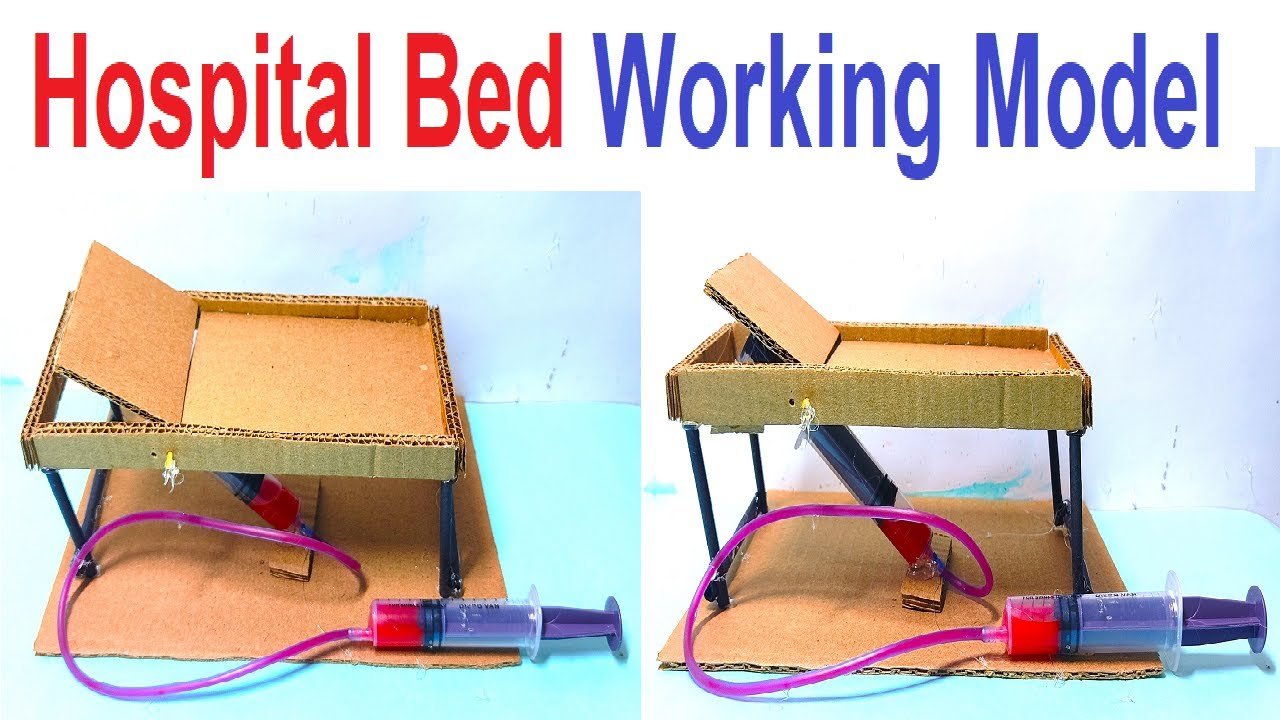A hospital bed is a specialized piece of medical equipment designed to provide comfort, support, and safety to patients in healthcare setting
Hospital beds are highly adjustable to accommodate patients with different medical conditions and to provide optimal comfort. They can be raised or lowered in height, and the head, foot, and middle sections can be adjusted independently.
Creating a working model of a hospital bed using cardboard and hydraulic syringes is a great hands-on project to understand basic principles of hydraulic systems.

Here’s a step-by-step guide on how to build this model:
Materials You’ll Need:
- Cardboard sheets (for the bed frame, headboard, and footboard)
- Hydraulic syringes (with plungers and tubes)
- Wooden sticks or dowels
- Small plastic containers or cups (for the bed surface)
- Craft knife or scissors
- Hot glue gun and glue sticks
- Rubber bands or string
- Craft supplies for decoration (paint, markers, stickers, etc.)
Steps to Build the hospital bed working Model:
- Prepare the Bed Frame:
- Cut out pieces of cardboard to create the bed frame, headboard, and footboard. The size can be adjusted based on your desired scale.
- Assemble the bed frame by gluing the cardboard pieces together.
- Create the Bed Surface:
- Attach the plastic containers or cups to the cardboard bed frame to serve as the bed surface. These will act as platforms for the hydraulic system.
- Attach Hydraulic Syringes:
- Attach the hydraulic syringes vertically to the bed frame, one on each side of the bed.
- Secure the syringes in place using hot glue or tape.
- Connect the Syringes:
- Attach tubes to the syringes’ plungers. Use rubber bands or string to connect the syringe plungers to each other. This will create a hydraulic connection between the syringes.
- Create the Hydraulic Mechanism:
- Connect a wooden stick or dowel to each syringe plunger. When you push one syringe’s plunger down, the other syringe’s plunger should move up, and vice versa.
- Test the Hydraulic System:
- Press the plunger of one syringe downward. Observe how the other syringe’s plunger moves upward due to the hydraulic pressure. This demonstrates the basic hydraulic principle.
- Bed Adjustments:
- Decorate the headboard and footboard using craft supplies to make the bed more realistic.
- If you want to demonstrate an adjustable bed, create a mechanism to lift or lower the bed using the hydraulic system. Attach strings or rods to the syringe plungers and the bed surface for this purpose.
- Final Touches:
- Make sure all components are securely attached and functioning smoothly.
- Add any additional decorations or details to enhance the appearance of the hospital bed.
By building this model, you’ll gain a better understanding of how hydraulic systems work and how they can be used for various applications, such as hospital beds with adjustable features. It’s also a fun and creative way to learn about basic engineering concepts and apply them to a practical project.
hydraulic concepts using syringes with questions and answers
Question 1: What is the basic principle behind hydraulic systems?
Answer: Hydraulic systems work on the principle that applying force to a confined fluid (such as oil or water) in one part of a system can transmit that force to another part of the system through pressure.
Question 2: How do syringes demonstrate hydraulic principles?
Answer: Syringes can demonstrate hydraulic principles because they contain a small volume of fluid (liquid), and applying force to the plunger of one syringe can transmit that force through the fluid to another syringe.
Question 3: How does Pascal’s law relate to hydraulic systems?
Answer: Pascal’s law states that any change in pressure applied to an enclosed fluid is transmitted undiminished throughout the fluid in all directions. In hydraulic systems, this law allows force to be transmitted across the system.
Question 4: Can you explain how a hydraulic lift works using syringes?
Answer: In a hydraulic lift using syringes, when force is applied to the plunger of one syringe (small piston), it increases the pressure on the fluid inside. This pressure is transmitted undiminished to the larger piston in another syringe, causing it to lift a heavier load.
Question 5: What are some practical applications of hydraulic systems in real life?
Answer: Hydraulic systems are used in various applications, such as car brakes, construction machinery, hydraulic jacks, cranes, and elevators, due to their ability to transmit force efficiently.
Question 6: How does the size of the syringe piston affect the force exerted?
Answer: According to Pascal’s law, the force exerted on a larger piston connected to the syringe with a smaller piston will be greater, since the pressure is transmitted undiminished. So, a larger piston will exert a higher force.
Question 7: What is the role of a hydraulic fluid in these systems?
Answer: The hydraulic fluid serves as a medium to transmit pressure. It does not compress easily, allowing the force applied to one part of the system to be efficiently transmitted to another part.
Question 8: Can you explain the concept of mechanical advantage in hydraulic systems?
Answer: Mechanical advantage refers to the amplification of force achieved by using a smaller force over a larger distance to lift a heavier load over a smaller distance. Hydraulic systems utilize this principle to lift heavy objects with relatively less effort.
Question 9: Are there any limitations to hydraulic systems?
Answer: Yes, hydraulic systems can experience leaks, which can lead to loss of pressure and reduced efficiency. Additionally, hydraulic systems require maintenance to ensure the fluid remains clean and functional.
Question 10: How do hydraulic systems contribute to energy efficiency?
Answer: Hydraulic systems can efficiently transmit force over a distance, enabling heavy loads to be lifted with less effort. This efficiency makes them valuable for applications where mechanical advantage and force multiplication are needed.

